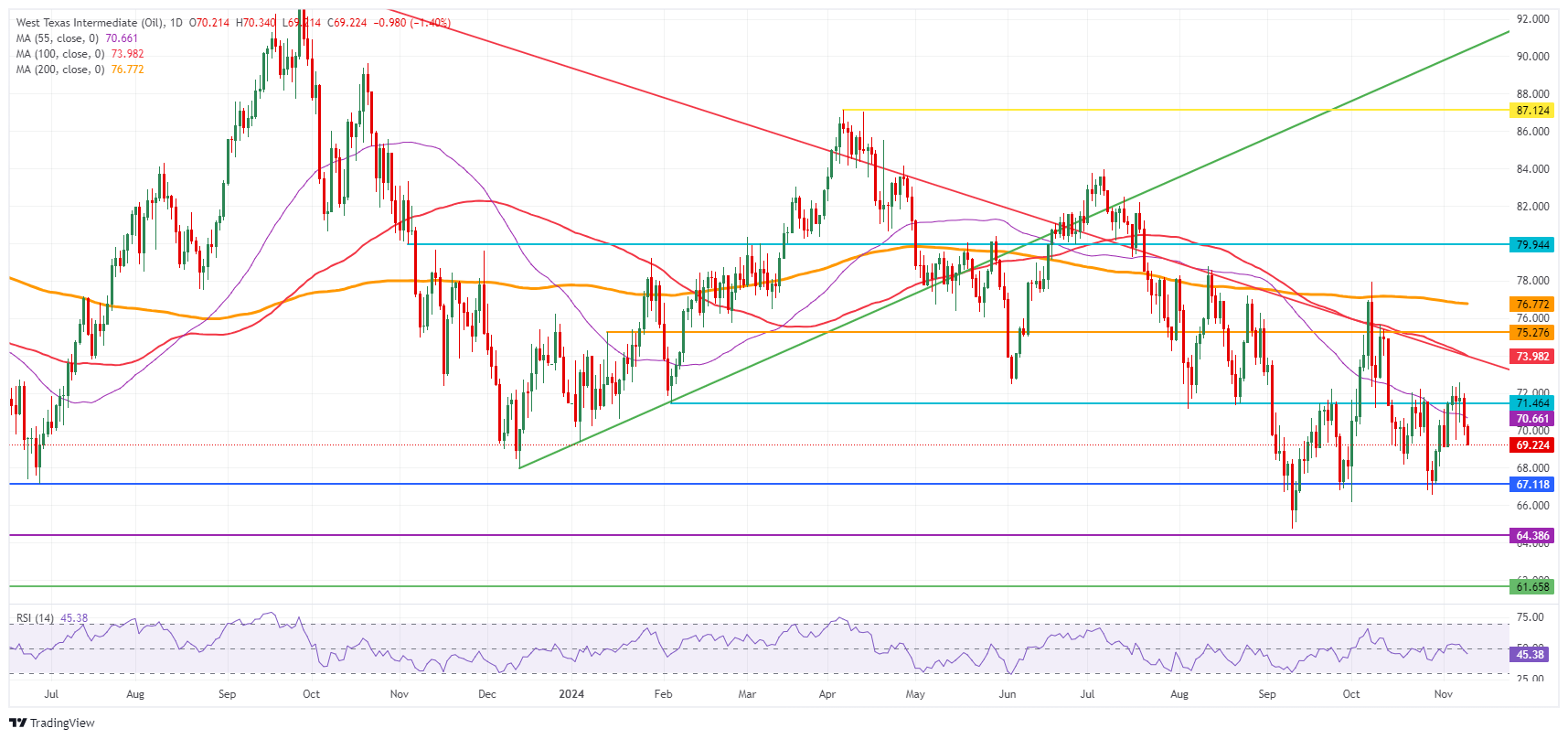- Crude Oil dips further away and hits rock bottom
- Traders remain focused on concerns over Chinese demand and OPEC’s impasse as key issues leading to oversupply.
- The US Dollar Index rallies further after President-elect Donald Trump enlarged his victory.
Crude Oil slides by more than 1% on Monday, piling on Friday’s losses and within touching distance of a seven-day low, ahead of the publication of the monthly OPEC report on Tuesday. Traders are already writing off the report as a non-event after OPEC already sidetracked on its production normalization last week by extending the measure by a month. Far from enough, traders also worry about Chinese demand for Oil once President-elect Donald Trump imposes tariffs on the country’s products.
The US Dollar Index (DXY), which tracks the performance of the Greenback against six other currencies, extends gains on Monday after headlines over the weekend that President-elect Donald Trump secured an additional swing state to its victory. All eyes are now on the count for the House of Representatives, where the Republicans are just four seats shy of the majority after already securing the Senate. Meanwhile, traders gear up for the US Consumer Price Index (CPI) on Wednesday.
At the time of writing, Crude Oil (WTI) trades at $68.40 and Brent Crude at $72.02.
Oil news and market movers: Trump looks for solution
- President-elect Donald Trump has urged Russian President Vladimir Putin to deescalate tensions in Ukraine, Bloomberg reports.
- The monthly OPEC report is due Tuesday near 12:00 GMT.
- Several markets and asset classes are closed or trading at low volumes for this Monday on Veteran’s Day.
- Saudi Aramco reportedly will only sell around 36 million barrels of contractual supplies for December, against 42 million barrels in November, Reuters reports.
- Russian officials and business executives have held talks about merging the country’s biggest Oil companies into a single producer, the Wall Street Journal reported.
Oil Technical Analysis: Ukraine peace would mean massive correction
Crude Oil prices are snapping lower again in search of a fresh one-week low. Traders’ expectations for any answers from OPEC on the oversupply issue look very minimal. The risk is that any form of communication from OPEC triggers more downside in Oil prices.
On the upside, The 55-day Simple Moving Average (SMA) at $70.66 is the first to be considered before the hefty technical level at $73.98, with the 100-day Simple Moving Average (SMA) and a few pivotal lines. The 200-day SMA at $76.77 is still quite far off, although it could get tested in case tensions in the Middle East arise.
Traders need to look much lower, towards $67.12, a level that held the price in May and June 2023, to find the first support. In case that level breaks, the 2024 year-to-date low emerges at $64.75, followed by $64.38, the low from 2023.
US WTI Crude Oil: Daily Chart
WTI Oil FAQs
WTI Oil is a type of Crude Oil sold on international markets. The WTI stands for West Texas Intermediate, one of three major types including Brent and Dubai Crude. WTI is also referred to as “light” and “sweet” because of its relatively low gravity and sulfur content respectively. It is considered a high quality Oil that is easily refined. It is sourced in the United States and distributed via the Cushing hub, which is considered “The Pipeline Crossroads of the World”. It is a benchmark for the Oil market and WTI price is frequently quoted in the media.
Like all assets, supply and demand are the key drivers of WTI Oil price. As such, global growth can be a driver of increased demand and vice versa for weak global growth. Political instability, wars, and sanctions can disrupt supply and impact prices. The decisions of OPEC, a group of major Oil-producing countries, is another key driver of price. The value of the US Dollar influences the price of WTI Crude Oil, since Oil is predominantly traded in US Dollars, thus a weaker US Dollar can make Oil more affordable and vice versa.
The weekly Oil inventory reports published by the American Petroleum Institute (API) and the Energy Information Agency (EIA) impact the price of WTI Oil. Changes in inventories reflect fluctuating supply and demand. If the data shows a drop in inventories it can indicate increased demand, pushing up Oil price. Higher inventories can reflect increased supply, pushing down prices. API’s report is published every Tuesday and EIA’s the day after. Their results are usually similar, falling within 1% of each other 75% of the time. The EIA data is considered more reliable, since it is a government agency.
OPEC (Organization of the Petroleum Exporting Countries) is a group of 12 Oil-producing nations who collectively decide production quotas for member countries at twice-yearly meetings. Their decisions often impact WTI Oil prices. When OPEC decides to lower quotas, it can tighten supply, pushing up Oil prices. When OPEC increases production, it has the opposite effect. OPEC+ refers to an expanded group that includes ten extra non-OPEC members, the most notable of which is Russia.
Information on these pages contains forward-looking statements that involve risks and uncertainties. Markets and instruments profiled on this page are for informational purposes only and should not in any way come across as a recommendation to buy or sell in these assets. You should do your own thorough research before making any investment decisions. FXStreet does not in any way guarantee that this information is free from mistakes, errors, or material misstatements. It also does not guarantee that this information is of a timely nature. Investing in Open Markets involves a great deal of risk, including the loss of all or a portion of your investment, as well as emotional distress. All risks, losses and costs associated with investing, including total loss of principal, are your responsibility. The views and opinions expressed in this article are those of the authors and do not necessarily reflect the official policy or position of FXStreet nor its advertisers. The author will not be held responsible for information that is found at the end of links posted on this page.
If not otherwise explicitly mentioned in the body of the article, at the time of writing, the author has no position in any stock mentioned in this article and no business relationship with any company mentioned. The author has not received compensation for writing this article, other than from FXStreet.
FXStreet and the author do not provide personalized recommendations. The author makes no representations as to the accuracy, completeness, or suitability of this information. FXStreet and the author will not be liable for any errors, omissions or any losses, injuries or damages arising from this information and its display or use. Errors and omissions excepted.
The author and FXStreet are not registered investment advisors and nothing in this article is intended to be investment advice.
Recommended content
Editors’ Picks

EUR/USD targets yearly highs beyond 1.1100
Significant losses in the US Dollar allow EUR/USD to edge closer to its yearly highs, comfortably trading beyond the 1.1100 level after US inflation and jobs data releases.

GBP/USD meets a decent barrier near 1.2950
GBP/USD secures its third straight day of gains, smashing well past the 1.2900 yardstick and reaching new weekly highs, fueled by the increasing selling pressure in the Greenback.

Gold looks consolidative around $3,130 after US data
Following US data releases, Gold prices now seem to have embarked on a consolidative range near the $3,130 mark. This robust performance comes amid a pronounced bearish bias in the Greenback and mixed US yields.

Cardano stabilizes near $0.62 after Trump’s 90-day tariff pause-led surge
Cardano stabilizes around $0.62 on Thursday after a sharp recovery the previous day, triggered by US Donald Trump’s decision to pause tariffs for 90 days except for China and other countries that had retaliated against the reciprocal tariffs announced on April 2.

Trump’s tariff pause sparks rally – What comes next?
Markets staged a dramatic reversal Wednesday, led by a 12% surge in the Nasdaq and strong gains across major indices, following President Trump’s unexpected decision to pause tariff escalation for non-retaliating trade partners.

The Best brokers to trade EUR/USD
SPONSORED Discover the top brokers for trading EUR/USD in 2025. Our list features brokers with competitive spreads, fast execution, and powerful platforms. Whether you're a beginner or an expert, find the right partner to navigate the dynamic Forex market.




